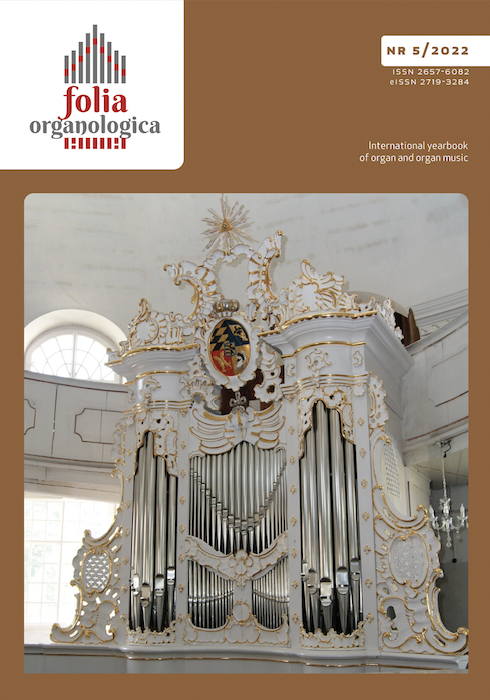Historia i teraźniejszość organów Filharmonii Opolskiej im. Józefa Elsnera
The history and the present of the organ of the Opole Philharmonic Hall
Author(s): Marzena RosińskaSubject(s): History, Fine Arts / Performing Arts, Cultural history, Music, History of Art
Published by: Uniwersytet Opolski
Keywords: Opole Philharmonic; organ; history; organ construction; technical condition
Summary/Abstract: The concert organ located in the Opole Philharmonic Concert Hall was ordered in1979 from the German company called Sauer. The forty-eight-voice instrument wasbrought to Opole a year later, but due to the ongoing reconstruction of the PhilharmonicHall building, its immediate installation upon delivery was not feasible. Accordingly,the unfolded elements of the instrument were hidden at the backstage. However,no-one expected them to remain there for another sixteen years! In 1994, as a result ofthe initiative of music lovers affiliated with the Philharmonic Hall, referred to as theOrgan Reconstruction Committee, funds began to be collected for the full installationof the instrument.Since it was impossible to attract a single strategic sponsor, the Organ ReconstructionCommittee raised money by selling certificates for particular organ pipes. Thelargest pipe in the Opole Philharmonic organ measures 8 metres in height, and thesmallest one – just 9 mm, so each of the 3,526 pipes had a different corresponding price.Despite the Committee’s involvement, the money raised did not cover all the requiredcosts. The Philharmonic Hall obtained the rest of the target amount from loans. Forthe installation of the organ, the Czech organ builder Vladimir Grygar from Prostějov,who had already carried out essential repair work on the organ in the Opole Cathedral,was hired.Ultimately, the instrument was installed in 1996. The inauguration ceremony wasplanned along with the grand concert opening the new artistic season on 20th September.The first sounds played on the organ – installed after sixteen years – were playedby Julian Gembalski, performing Toccata and Fugue in D minor BWV 565 by Johann SebastianBach. The remaining part of the evening was filled with music accompanied bythe Opole Philharmonic Orchestra conducted by Janusz Powolny. Francis Poulenc’s OrganConcerto and Camille Saint-Saëns’ Symphony No. 2 in C minor, Op. 78, also knownas the Organ Symphony, were performed.Unfortunately, merely a year later Opole was hit by the so-called Flood of the Millennium,damaging both the Philharmonic Hall building and the instrument locatedinside of it. The organ was played again in the artistic season of 1998/1999. In the followingseasons, the Opole Philharmonic Hall’s concert programs regularly featured organrepertoire, both in recitals and as an accompaniment during concerts with the orchestra.However, the subsequent plans to expand the Opole Philharmonic Hall buildingdisrupted the regularity of the flow of those concerts, and the technical condition ofthe instrument began to deteriorate again.Additionally, in 2005 and 2011 the building underwent some further reconstructionwork, enlarging the auditorium of the Concert Hall and of the whole building itself.Despite the strong efforts of the successive Directors of the Philharmonic Hall, all therenovation works did affect the technical condition of the organ again. In the last severalyears, the instrument has been in need of a major overhaul.The current Director of the institution – Przemysław Neumann, however, does notgive up the organ repertoire, trying to maintain the most magnificent instrument in theOpole Philharmonic Concert Hall in good shape. The organ was the main “protagonist”of a cycle entitled In old cinema, during which screenings of old silent films with livemusic improvised the organ by Karol Mossakowski were presented. The annual organconcerts inaugurating the new school year, performed by the students and teachers ofthe Diocesan Institute of Church Music in Opole, have also become a solid tradition.The difficult history of this remarkable instrument – the Opole Philharmonic organ– is already 42 years old. Although the instrument was created to take active partin the institution’s concert activities, it still appears in concert programs too rarely todemonstrate its full potential. This text presents both the remarkable history of theorgan situated inside the Opole Philharmonic Hall, its construction, and it also provesthe current technical condition of the instrument as well as the scope of the renovationwork required to be performed in the coming future to make the instrument sound inits full glory again.
Journal: Folia Organologica. International yearbook of organ and organ music
- Issue Year: 2022
- Issue No: 5
- Page Range: 40-53
- Page Count: 14
- Language: English, Polish

